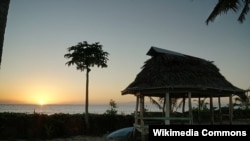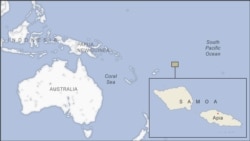China’s diplomatic and strategic expansion into the South Pacific appears to have run aground – at least temporarily – in Samoa, where a Beijing-allied leader has been defeated in a history-making election.
A three-month constitutional crisis was resolved in late July, when Samoa’s Supreme Court declared the office of prime minister had been rightfully won by the nation’s first female chief executive, 64-year-old Fiame Naomi Mata’afa.
Among the top issues in the election, which narrowly unseated long-serving Prime Minister Tuila’epa Sa’ilele Malielegaoi, was a pledge by Fiame to reconsider a Beijing-financed deal for a major expansion of the island’s seaport at Vaiusu Bay.
Making good on her promise, Fiame promptly announced that she was shelving the $100 million project, saying the proposed expansion exceeded Samoa’s needs and would leave it with too much debt.
The decision will send ripples far beyond the island republic of just over 200,000 people, according to James Fanell, former director of intelligence for the U.S. Pacific Fleet, who sees it disrupting Beijing’s efforts to woo island nations that recognize Taiwan at the United Nations and expand the reach of Beijing’s fast-growing navy.
Reversal of trend
“It reverses the trend of nations in the South Pacific aligning with the [People’s Republic of China], which Beijing had built up before COVID-19 in nations like Kiribati and the Solomon Islands that both switched diplomatic recognition from Taiwan to the PRC [in 2019],” Fanell said in an interview.
“The reversal of fortunes in Samoa could be a harbinger of more nations reversing course and rejecting the debt-trap model” offered by Beijing, he said.
Fanell said the decision also portends “a delay or disruption” of Beijing’s self-proclaimed plans to develop a blue-water economic corridor into the South Pacific.
The implications are profound, he said, “as it could keep the [People’s Liberation Army] from building a string of naval bases that could not only cut off Australia and New Zealand but also threaten U.S. assets in Hawaii and even the West Coast” of the United States.
Charles Edel, who served on the U.S. secretary of state’s policy planning staff from 2015 to 2017, said Fiame’s election also marked a political setback for Beijing, which had used its financial muscle to try to bolster the incumbent.
"The idea that in the weeks before the election Beijing attempted to boost the incumbent’s political fortunes by rolling out a package of economic inducements, including refurbishment of a port at one-third of the cost and dangling a number of other strategic partnerships, seems to have had the opposite effect,” Edel told VOA.
China’s aggressive economic expansion and “wolf warrior” diplomacy are increasingly rattling its Asian neighbors. At the same time, Edel said, “countries’ relations with China are becoming an election issue,” with voters scrutinizing leaders who are too close to Beijing.
Plans snagged
That in turn complicates China’s efforts to marginalize Taiwan at the U.N. by getting more countries to abandon diplomatic relations with Taipei.
“Beijing’s growing focus on the Pacific islands in recent years is directly related to its effort to erode and complicate the U.S. military presence and political influence in the region,” said J. Michael Cole, a Taipei-based analyst.
“This focus is also related to ongoing tensions with Taiwan, which counts among Pacific island nations [nearly] one-third of the number of countries that have official diplomatic ties with it,” he told VOA.
Chinese leader Xi Jinping has visited Pacific island nations twice since he became top leader in 2013, highlighting the level of attention his government gives to the region.
Despite the setback in Samoa, Edel cautioned that the Pacific is vast, and given what he described as China’s “fluid and opportunistic” approach, Beijing will attempt to exploit other targets and opportunities.
China's strategy
He said China tends to carve out strategic advantages overseas through “incremental advances calculated not to trigger a significant response and actions intended to remain ambiguous until they are presented as a fait accompli.”
“Beijing’s playbook in each case involves investment in a country’s critical infrastructure, acquisition of a significant piece of waterfront territory by a Chinese company, and assertions by Chinese officials that the activity is purely commercial or humanitarian,” he told VOA.
“In actuality, the denials typically precede future actions toward Beijing’s true aims,” which are “military, political and economic,” he said.
Edel said it helps to understand Beijing’s strategy in the South Pacific by examining what it has done closer to home in the South China Sea.
“If you look through the lens of how Beijing operated in the South China Sea, their forceful seizure of land, buildup of facilities and militarization of those features with the deployment of military assets were intended to cast a threatening shadow over Southeast Asia’s politics and increase risks to the United States’ ability to access the region,” he said.
"Similarly, if you begin having Chinese military facilities in some Pacific islands, that complicates the military planning, logistical staging needed for the United States to access the region. And it would be hard to imagine a Chinese military positioned across the Pacific that doesn’t shape the region’s politics.”
Samoa, meanwhile, can be expected to present a new, highly independent face to its South Pacific neighbors, according to Cleo Paskal, an associate fellow at London-based Chatham House and a nonresident senior fellow at the Foundation for Defense of Democracies headquartered in Washington.
Paskal told VOA that Fiame is “strong, independent, and she cares about her country and her people. She will stand up to Beijing. And for the same reasons she will also stand up to [New Zealand] and [Australia] when their plans for Samoa don't align with hers.”
The best thing for everyone in the region, Paskal said, is “strong, independent leaders who care about their people and countries and who align [with democratic nations] out of choice to make the region more secure and prosperous for all.”











